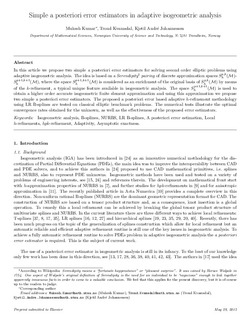| dc.contributor.author | Kumar, Mukesh | |
| dc.contributor.author | Kvamsdal, Trond | |
| dc.contributor.author | Johannessen, Kjetil Andre | |
| dc.date.accessioned | 2018-03-09T10:12:28Z | |
| dc.date.available | 2018-03-09T10:12:28Z | |
| dc.date.created | 2015-05-29T15:58:38Z | |
| dc.date.issued | 2015 | |
| dc.identifier.citation | Computers and Mathematics with Applications. 2015, 70 (7), 1555-1582. | nb_NO |
| dc.identifier.issn | 0898-1221 | |
| dc.identifier.uri | http://hdl.handle.net/11250/2489721 | |
| dc.description.abstract | n this article we propose two simple a posteriori error estimators for solving second order elliptic problems using adaptive isogeometric analysis. The idea is based on a Serendipity1pairing of discrete approximation spaces Shp,k(M)–Shp+1,k+1(M), where the space Shp+1,k+1(M) is considered as an enrichment of the original basis of Shp,k(M) by means of the k-refinement, a typical unique feature available in isogeometric analysis. The space Shp+1,k+1(M) is used to obtain a higher order accurate isogeometric finite element approximation and using this approximation we propose two simple a posteriori error estimators. The proposed a posteriori error based adaptive h-refinement methodology using LR B-splines is tested on classical elliptic benchmark problems. The numerical tests illustrate the optimal convergence rates obtained for the unknown, as well as the effectiveness of the proposed error estimators. | nb_NO |
| dc.language.iso | eng | nb_NO |
| dc.publisher | Elsevier | nb_NO |
| dc.relation.uri | http://www.sciencedirect.com/science/article/pii/S0898122115002862 | |
| dc.rights | Attribution-NonCommercial-NoDerivatives 4.0 Internasjonal | * |
| dc.rights.uri | http://creativecommons.org/licenses/by-nc-nd/4.0/deed.no | * |
| dc.subject | Adaptive metoder | nb_NO |
| dc.subject | Adaptive methods | nb_NO |
| dc.subject | Feilestimering | nb_NO |
| dc.subject | Error estimation | nb_NO |
| dc.subject | Elementmetoder | nb_NO |
| dc.subject | Finite element methods | nb_NO |
| dc.subject | Splines | nb_NO |
| dc.title | Simple a posteriori error estimators in adaptive isogeometric analysis | nb_NO |
| dc.type | Journal article | nb_NO |
| dc.type | Peer reviewed | nb_NO |
| dc.description.version | acceptedVersion | nb_NO |
| dc.subject.nsi | VDP::Matematikk og naturvitenskap: 400 | nb_NO |
| dc.subject.nsi | VDP::Mathematics and natural scienses: 400 | nb_NO |
| dc.source.pagenumber | 1555-1582 | nb_NO |
| dc.source.volume | 70 | nb_NO |
| dc.source.journal | Computers and Mathematics with Applications | nb_NO |
| dc.source.issue | 7 | nb_NO |
| dc.identifier.doi | 10.1016/j.camwa.2015.05.031 | |
| dc.identifier.cristin | 1245256 | |
| dc.relation.project | Norges forskningsråd: 193823 | nb_NO |
| dc.relation.project | Norges forskningsråd: 187993 | nb_NO |
| dc.description.localcode | © 2015 Elsevier Ltd. All rights reserved. This is the authors’ accepted and refereed manuscript to the article. This manuscript version is made available under the CC-BY-NC-ND 4.0 license http://creativecommons.org/licenses/by-nc-nd/4.0/ | nb_NO |
| cristin.unitcode | 194,63,15,0 | |
| cristin.unitname | Institutt for matematiske fag | |
| cristin.ispublished | true | |
| cristin.fulltext | postprint | |
| cristin.qualitycode | 1 | |

